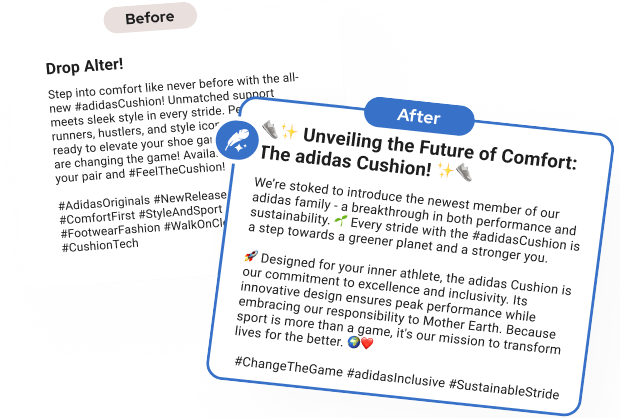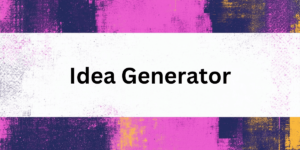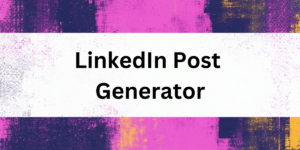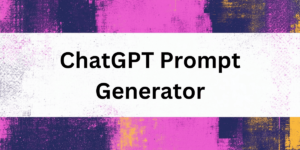Free Idea Generator
How to use the neuroflash Idea Generator


Type in ideas
Enter the topic that you want to write about or a short description in the text field. If necessary, you can select the desired writing style (e.g. serious or casual), length or language.
Generate text
Click on the “Generate” button and the neuroflash idea generator will create a suitable text in seconds. Depending on the input, it can be a paragraph, a list or an entire article.
Edit text
Read through the generated text and adapt it according to your wishes. You can add content, reword it or remove unwanted parts. If the result doesn't suit you, you can simply regenerate the text.
Idea Generator
🏆 Use Germany's leading AI content software
Generate on-brand AI texts and images for free every month! Including AI chatbot, 100+ prompt templates and more.
Table of contents
Imagine a spark that transforms a fleeting thought into a cascade of breakthrough ideas. Our idea generator turns simple prompts into a creative powerhouse, fueling innovation in business, marketing, and beyond. Ready to unlock your creative genius and see where a single spark can lead?
In this post, we’ll dive into the magic behind these tools, explore real-life success stories, and reveal how a single spark can ignite a wildfire of creativity. If you’re ready to unlock your creative genius and revolutionize your brainstorming process, read on and let inspiration take flight.
Key Takeaways: Idea Generator
- Idea generators spark creativity: They use tools and methods to overcome mental blocks.
- They combine AI and human input: Technology finds data, people add unique perspectives.
- They apply to various fields: Useful for marketing, content creation, and product development.
- They improve efficiency and creativity: Saving time and generating diverse ideas.
- Using trends and user content inspires innovation: Seeing what’s popular and what people create helps.
- Structured methods like SCAMPER boost brainstorming: These methods help change current ideas into new ones.
What Is an Idea Generator?
An idea generator is more than a simple random word tool—it’s a creative catalyst designed to help you overcome mental blocks and unlock new possibilities. At its core, an idea generator is a tool designed to stimulate creative thinking and facilitate brainstorming. By taking in a simple prompt—such as a keyword or a challenge—the generator produces a wide range of innovative ideas. These tools leverage advanced technologies like artificial intelligence, coupled with time-tested creative techniques, to turn your initial spark into a wealth of potential solutions.

Modern idea generators blend human ingenuity with algorithmic intelligence, leveraging data, market trends, and even artificial intelligence to offer both spontaneous prompts and structured suggestions.
- Evolution of the Concept:
Early brainstorming relied on human interaction alone, but with the advent of digital tools and AI, idea generators have evolved into sophisticated platforms that not only provide random prompts but also analyze consumer data, social trends, and competitive landscapes to deliver tailor‐made inspiration. - Integration with Innovation Management:
In today’s digital age, idea generators are a vital part of innovation management. They serve as the “front end” of ideation—fueling processes that lead from concept to market launch.
How Does an Idea Generator Work?
Idea generators work by combining elements of randomness with structured algorithms.
Here’s a closer look at their inner mechanics:
- Randomized Prompts:
Some tools offer completely random words or phrases that push your thinking in new directions, encouraging the unexpected. - Structured Algorithms:
Other systems use keyword analysis, natural language processing, and AI-driven trend analysis to provide ideas that are relevant to specific topics or industries.
For example, tools may analyze search engine data or social media buzz to suggest topics that resonate with current audience interests.
- User-Defined Customization:
Many modern platforms allow you to refine outputs by setting parameters such as industry, tone, or target audience, thus merging creative randomness with data-driven insight.
Idea Generator’s Workflow:

An Idea Generator is a tool or methodology designed to facilitate the creation of new concepts, solutions, or strategies. Its workflow typically encompasses several key stages:
- Problem Definition: Clearly identify the issue or challenge that requires innovative solutions.
- Input Gathering: Collect relevant data, insights, or prompts that will serve as the foundation for idea generation.
- Idea Generation: Utilize brainstorming techniques, AI-powered tools, or collaborative sessions to produce a diverse set of ideas.
- Idea Evaluation: Assess the feasibility, originality, and potential impact of the generated ideas to identify the most promising ones.
- Implementation Planning: Develop actionable plans to bring the selected ideas to fruition, including resource allocation and timeline establishment.
- Review and Iteration: Continuously monitor the implementation process, gather feedback, and refine the ideas as necessary to ensure optimal outcomes.
This structured approach ensures a comprehensive and effective pathway from initial problem identification to the successful realization of innovative solutions.
Why It Matters in Marketing and Business
In an era where the business landscape is constantly evolving, traditional brainstorming methods can sometimes fall short. Idea generators help overcome common hurdles like mental blocks, limited perspectives, and the pressure of generating “perfect” ideas right off the bat.
Idea generators are essential in today’s competitive landscape for several reasons:
- Enhanced Creativity and Efficiency:
By automating the initial brainstorming process, idea generators help teams generate a high volume of diverse ideas quickly. This speed and variety provide a competitive edge, particularly in marketing where fresh content is king. - Overcoming Creative Blocks:
Many professionals experience stagnation when ideas dry up. A robust idea generator not only offers prompts but can also act as a thought partner—challenging your assumptions and encouraging out-of-the-box thinking. - Data-Driven Innovation:
In marketing and product development, leveraging data from consumer behavior, trend analyses, and keyword research can lead to ideas that are both creative and market-ready. This alignment of creativity with data increases the likelihood of successful campaigns and products. - Cost and Time Savings:
Reducing the time spent in endless brainstorming sessions means resources can be reallocated to refining and implementing the best ideas, making the innovation process leaner and more effective.
Use Cases for Idea Generators
Idea generators have a wide array of applications across multiple fields. Some popular use cases include:
- Content Creation and Blogging:
Generate engaging blog topics, article outlines, and social media posts.
- Marketing Campaigns:
From slogans to full-blown campaign concepts, idea generators can provide the spark needed to create persuasive marketing materials.
- Business Naming and Branding:
Developing a memorable business or product name is critical. Business name generators combine linguistic creativity with market research to produce unique names that resonate with your target audience.
- Product Development:
Whether brainstorming new features or entirely new products, idea generators help teams quickly explore a broad spectrum of possibilities, encouraging innovation from concept to prototype.
- Creative Projects:
From art and design to writing novels and crafting speeches, these tools can help break creative blocks and offer fresh perspectives.
Benefits of Using Idea Generators:
- Enhanced Creativity:
With an idea generator, you no longer have to struggle for inspiration. The sheer volume of ideas produced can lead to unexpected, innovative solutions that you might never have conceived on your own.
- Time Efficiency:
Traditional brainstorming sessions can be time-consuming and sometimes unproductive. Idea generators streamline the process, giving you a broad range of concepts in minutes rather than hours.
- Collaborative Innovation:
Digital platforms enable teams to work together seamlessly, integrating diverse viewpoints and ensuring that the final ideas are well-rounded and practical.
- Data-Driven Insight:
By incorporating market research and consumer data, idea generators can produce ideas that are not only creative but also relevant and aligned with current trends and demands.
The Brainstorming Process: Crafting Random and Structured Prompts
Effective brainstorming is the heart of ideation. Here’s how you can enhance this process:
- Balancing Randomness and Structure:
Use a combination of free-form, random prompts and structured, targeted questions. For instance, start with a list of random words to break your habitual thought patterns, then narrow the focus by asking specific, structured questions related to your goal.
- Techniques to Enhance Group Creativity:
Incorporate methods such as SCAMPER (Substitute, Combine, Adapt, Modify, Put to another use, Eliminate, Reverse) or mind mapping. These methods encourage you to reframe problems and explore alternative solutions.
- Individual and Collaborative Brainstorming:
While group brainstorming is valuable for diverse input, individual sessions (or brainwriting) allow deep, uninterrupted thought. Combining both approaches ensures that every idea is heard and built upon (refer to Wikipedia’s discussion on brainstorming.
- Tools to Facilitate the Process:
Digital whiteboards and collaborative platforms (e.g., Miro, Notion) can help organize and visually map out ideas, making it easier to see connections and spot gaps.
How the SCAMPER Method Fuels Idea Generation
Creativity is essential in problem-solving, innovation, and business growth. But coming up with fresh ideas isn’t always easy. That’s where the SCAMPER method comes in—a powerful brainstorming technique that helps generate new concepts by modifying existing ones.
The SCAMPER method is a creativity and problem-solving technique designed to help generate new ideas by applying different thinking approaches to existing concepts, products, or processes. It is widely used in brainstorming sessions, product development, and innovation.
SCAMPER stands for:
- Substitute – Replace a part of the idea with something else.
- Combine – Merge two or more ideas, features, or concepts.
- Adapt – Modify an existing idea to fit a new use or context.
- Modify (or Magnify/Minify) – Alter the size, shape, or attributes to create improvement.
- Put to another use – Repurpose an idea or product in a different way.
- Eliminate – Remove unnecessary parts to simplify or streamline.
- Rearrange (or Reverse) – Change the order, pattern, or perspective to see new possibilities.
By asking specific questions under each category, individuals or teams can unlock fresh perspectives and innovations. It’s often used in:
- Business innovation (e.g., improving products/services)
- Marketing strategies (e.g., creating new campaigns)
- Problem-solving (e.g., redesigning inefficient processes)
- Education & brainstorming (e.g., teaching creative thinking)
Integrating SCAMPER with AI for Idea Generation
Combining the SCAMPER method with an AI Idea Generator can supercharge creativity and innovation. AI tools can process vast amounts of data, recognize patterns, and suggest unique ideas, making them an excellent partner for structured brainstorming methods like SCAMPER.

How to:
1. Use AI to Analyze Trends & Generate a Base Idea
AI tools (like ChatGPT, Jasper, or Notion AI) can suggest ideas based on market trends, customer needs, or industry insights.
Example: An AI-powered product research tool analyzes trending consumer behaviors and suggests a base idea for a new fitness app.
2. Apply SCAMPER with AI Assistance
Instead of manually brainstorming SCAMPER prompts, you can use AI to generate multiple alternatives for each SCAMPER category.
Example:
- Substitute – “What if we replace manual workout tracking with AI-driven voice commands?”
- Combine – “What happens if we integrate AR into fitness routines?”
- Adapt – “Can we modify this app to serve differently-abled users?”
4. Evaluate and Refine Ideas Using AI Insights
AI can predict which SCAMPER-inspired idea has the highest potential based on user feedback, engagement trends, or historical data.
Creative Inspiration: Trends and User-Generated Content
Here’s a breakdown of how trends and UGC can inspire you creatively:
1. Trends as Creative Catalysts:
- Understanding the Cultural Pulse: Trends are essentially signals of shifting cultural, societal, technological, and aesthetic preferences. They highlight what’s capturing attention, resonating with audiences, and emerging as the “next big thing.” By paying attention to trends, you’re tapping into the current cultural conversation and understanding evolving desires.
- Identifying Needs and Desires: Trends often emerge because they address unmet needs or evolving desires within a population. A trend in minimalist design might reflect a desire for simplicity and calm in an increasingly complex world. Understanding the why behind a trend can be deeply inspirational for creating solutions, products, or experiences that genuinely connect with people.
- Breaking Norms and Conventions: Trends can challenge established norms and creative conventions. Think of the punk movement challenging traditional music and fashion, or the rise of user-generated content itself challenging traditional media gatekeepers. Observing trend shifts can inspire you to question existing boundaries and explore new territories.
- Providing a Starting Point & Framework: Trends don’t have to be rigidly followed, but they can offer a valuable starting point. They provide a context, a set of themes, or a style that you can then interpret, subvert, or build upon in your own unique way. It’s about using the trend as a springboard, not a template.
- Generating Timeliness and Relevance: Creating work that resonates with current trends can automatically feel more relevant and timely. This can be particularly important in fields like marketing, fashion, and content creation where capturing current attention is key.
2. User-Generated Content (UGC) as a Wellspring of Inspiration:
- Direct Connection to the Audience: UGC offers an unfiltered and authentic glimpse into the thoughts, feelings, expressions, and creations of your target audience (or a broader audience). It’s a direct line to understanding what people are actually interested in, how they communicate, and what resonates with them on a personal level.
- Authenticity and Relatability: UGC often feels more genuine and relatable than highly polished, professionally produced content. This authenticity can be incredibly inspiring as it reflects real human experiences and perspectives. It can remind you of the core human element in your creative field.
- Unfiltered Perspectives and Ideas: UGC surfaces a diverse range of voices and perspectives that might be missed by traditional media or curated sources. This unfiltered nature can lead to unexpected and novel ideas, uncovering niche interests, and revealing untapped creative avenues.
- Community and Collaboration: UGC often exists within communities and fosters collaboration. Observing how people interact, remix, and build upon each other’s content can be incredibly inspiring for collaborative projects and community-driven creative endeavors.
- Identifying Pain Points and Needs (from a user perspective): UGC like reviews, forum posts, and social media discussions can highlight user frustrations, unmet needs, and desired improvements within a product, service, or industry. This is invaluable inspiration for problem-solving and creating user-centric solutions.

Examples of UGC-Inspired Creativity:
- Product Development:
Companies analyze user reviews, social media feedback, and forum discussions to identify product improvements and new feature ideas directly inspired by user needs and desires.
- Content Creation (Social Media):
Viral trends often start with UGC. Creators then draw inspiration from successful UGC formats, challenges, and memes to create their own engaging content.
- Gaming:
Game developers often look at player-created mods, fan art, and gameplay videos for inspiration on new game features, storylines, or even entirely new game concepts.
- Art & Design:
Artists can be inspired by street art shared on social media, photography trends from platforms like Instagram, or DIY projects showcased on platforms like Pinterest.
- Writing & Storytelling:
Personal stories shared on blogs, social media, and forums can provide rich inspiration for characters, plots, and themes in novels, screenplays, and other forms of storytelling.
3. The Synergy: Trends and UGC Working Together:
The power of trends and UGC is amplified when they are considered together.
- Trends are often revealed and spread through UGC:
Social media platforms, for example, are crucial in identifying and amplifying trends. Hashtags, viral challenges, and shared content patterns are the data points that define many modern trends.
- UGC can shape and modify trends:
While trends can emerge from top-down sources, UGC can significantly alter their trajectory. User interpretations, parodies, remixes, and adaptations of trends can give them new meaning and direction.
- Analyzing UGC within the context of a trend provides deeper insights:
Looking at how people are engaging with a trend through UGC reveals nuances, motivations, and emotional connections that go beyond simply identifying the trend itself.
4. Practical Ways to Leverage Trends and UGC for Inspiration:
- Actively Monitor Trend Platforms:
Utilize trend forecasting websites, social media trend dashboards, industry publications, and platforms like Google Trends to stay informed about emerging and current trends.
- Deep Dive into UGC Platforms:
Explore social media platforms (TikTok, Instagram, Twitter, YouTube), online forums (Reddit, niche communities), review sites, and comment sections relevant to your creative field.
- Listen to the Conversation (Social Listening):
Use social listening tools to track keywords, hashtags, and brand mentions related to trends or your industry to understand public sentiment and UGC conversations.
- Analyze UGC for Patterns and Themes:
Look beyond individual pieces of UGC and identify recurring themes, styles, questions, frustrations, and desires expressed within the content.
- Engage with UGC Creators and Communities:
Don’t just observe – participate! Engage with UGC creators, ask questions, leave comments, and participate in online communities to gain deeper insights and potentially spark collaborations.
- Combining Human Touch with AI:
While AI offers extensive data and rapid output, the best ideas come from a balanced mix of machine precision and human creativity. This “human in the loop” model ensures that the final output is both innovative and deeply connected to your brand’s voice.
Content and Blog Idea Generators: From Keywords to Concepts
For content creators and bloggers, idea generators are indispensable:
- Keyword-Driven Inspiration:
Many tools work by analyzing popular search terms and keyword data. By inputting a few keywords, you can receive a curated list of blog topics, content outlines, and SEO-friendly titles.
- Competitive Analysis:
Some platforms scan competitor content and trending topics to suggest ideas that help you differentiate your content and fill market gaps.
- Automated Outlines and Templates:
Advanced AI writing assistants can even provide detailed content outlines, ensuring that your articles not only attract attention but also perform well in search engine rankings.
- Examples in Action:
Tools like neuroflash not only generate topic ideas but also offer suggestions for headlines, subheadings, and even draft sections to jumpstart your writing process.
Business and Naming Idea Generators: Crafting Unique Identities
When it comes to branding, a memorable name and distinctive identity are crucial:
- Creative Algorithms for Naming:
Business name generators use sophisticated algorithms that blend keywords, market trends, and linguistic creativity to produce names that are catchy, unique, and reflective of your brand’s values. - Tailored to Your Industry:
These tools often allow you to input your industry or business focus, ensuring that the suggested names are relevant and resonant with your target audience. - Beyond Names—Building an Identity:
Some platforms extend beyond mere naming and offer complete branding kits, including slogans, logos, and mission statements. This holistic approach helps in creating a consistent brand image. - Real-World Success Stories:
Many startups have successfully used these tools to generate names that helped them secure funding and carve out a niche in competitive markets.
Best Practices for Maximizing Your Idea Generation
1. Clearly Define the Problem or Opportunity
A well-defined problem leads to more relevant and impactful ideas. Be specific about the challenge you’re trying to solve.
2. Encourage a Judgment-Free Environment
Let creativity flow without fear of criticism. The best ideas often start as wild or unconventional thoughts.
3. Involve Diverse Perspectives
Gather input from people with different backgrounds, experiences, and expertise. Diversity sparks creativity and new insights.
4. Use Structured Techniques
Try brainstorming, SCAMPER, mind mapping, or other frameworks to guide idea generation and prevent creative blocks.
5. Combine and Improve Ideas
Innovation often comes from refining and merging multiple ideas. Encourage collaboration and iteration to develop stronger concepts.
Conclusion
An idea generator is more than a digital tool—it’s a vital partner in sparking creativity. From initiating blog topics and marketing strategies to devising unique business names and surmounting creative hurdles, these tools provide limitless opportunities for innovation. By combining random and structured prompts, and leveraging AI and data-driven insights, you can consistently refresh your creative projects with novel, impactful ideas.
Whether aiming to enhance your content strategy, boost marketing efforts, or simply find inspiration, exploring idea generators could be the key to your next significant breakthrough.
Embrace the creative journey—start exploring our free idea generator and discover where your new inspiration leads you!
FAQ

What is the best idea generator for AI?
What is an idea generator?
An idea generator is a tool used to spark creativity and generate new concepts or solutions. It can help individuals or teams come up with innovative ideas for projects, products, or services.
What types of ideas can it generate?
The tool can generate a wide range of ideas, including product concepts, business strategies, creative campaign ideas, and even solutions to specific problems. The output depends on the details and context you provide.
Can I customize or refine the generated ideas?
Yes, most platforms, like neuroflash, allow you to tweak the parameters, add specific keywords, or provide additional context so that the ideas better match your needs.
Are the generated ideas unique?
While AI generates ideas based on vast amounts of data, the uniqueness of the output depends on the specificity of your input. Iterating and refining your prompts can help produce more varied results.
Use now for free - without sign-up

Creating content has never been easier -
Get started for free!
Keine Kreditkarte notwendig.








